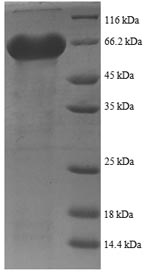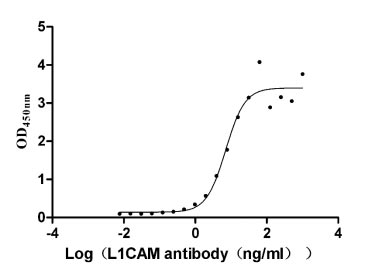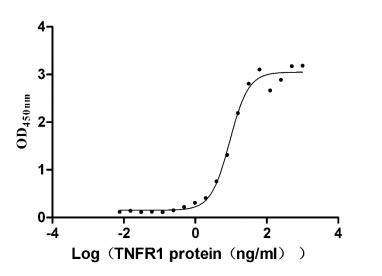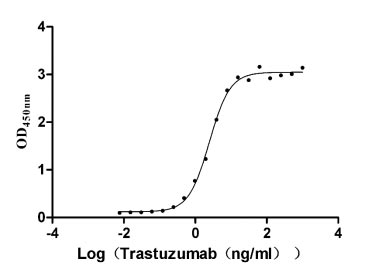Recombinant Human immunodeficiency virus type 1 group M subtype B Envelope glycoprotein gp160 (env), partial
In Stock-
货号:CSB-EP361302HKP
-
规格:¥1344
-
图片:
-
其他:
产品详情
-
纯度:Greater than 90% as determined by SDS-PAGE.
-
基因名:env
-
Uniprot No.:
-
别名:envEnvelope glycoprotein gp160; Env polyprotein) [Cleaved into: Surface protein gp120; SU; Glycoprotein 120; gp120); Transmembrane protein gp41; TM; Glycoprotein 41; gp41)]
-
种属:Human immunodeficiency virus type 1 group M subtype B (isolate HXB2) (HIV-1)
-
蛋白长度:Partial
-
来源:E.coli
-
分子量:69.7 kDa
-
表达区域:33-511aa
-
氨基酸序列KLWVTVYYGVPVWKEATTTLFCASDAKAYDTEVHNVWATHACVPTDPNPQEVVLVNVTENFNMWKNDMVEQMHEDIISLWDQSLKPCVKLTPLCVSLKCTDLKNDTNTNSSSGRMIMEKGEIKNCSFNISTSIRGKVQKEYAFFYKLDIIPIDNDTTSYKLTSCNTSVITQACPKVSFEPIPIHYCAPAGFAILKCNNKTFNGTGPCTNVSTVQCTHGIRPVVSTQLLLNGSLAEEEVVIRSVNFTDNAKTIIVQLNTSVEINCTRPNNNTRKRIRIQRGPGRAFVTIGKIGNMRQAHCNISRAKWNNTLKQIASKLREQFGNNKTIIFKQSSGGDPEIVTHSFNCGGEFFYCNSTQLFNSTWFNSTWSTEGSNNTEGSDTITLPCRIKQIINMWQKVGKAMYAPPISGQIRCSSNITGLLLTRDGGNSNNESEIFRPGGGDMRDNWRSELYKYKVVKIEPLGVAPTKAKRRVVQREKR
Note: The complete sequence including tag sequence, target protein sequence and linker sequence could be provided upon request. -
蛋白标签:N-terminal 6xHis-SUMO-tagged
-
产品提供形式:Liquid or Lyophilized powder
Note: We will preferentially ship the format that we have in stock, however, if you have any special requirement for the format, please remark your requirement when placing the order, we will prepare according to your demand. -
缓冲液:Tris-based buffer,50% glycerol
-
储存条件:Store at -20°C/-80°C upon receipt, aliquoting is necessary for mutiple use. Avoid repeated freeze-thaw cycles.
-
保质期:The shelf life is related to many factors, storage state, buffer ingredients, storage temperature and the stability of the protein itself.
Generally, the shelf life of liquid form is 6 months at -20°C/-80°C. The shelf life of lyophilized form is 12 months at -20°C/-80°C. -
货期:3-7 business days
-
注意事项:Repeated freezing and thawing is not recommended. Store working aliquots at 4°C for up to one week.
-
Datasheet & COA:Please contact us to get it.
相关产品
靶点详情
-
功能:Oligomerizes in the host endoplasmic reticulum into predominantly trimers. In a second time, gp160 transits in the host Golgi, where glycosylation is completed. The precursor is then proteolytically cleaved in the trans-Golgi and thereby activated by cellular furin or furin-like proteases to produce gp120 and gp41.; Attaches the virus to the host lymphoid cell by binding to the primary receptor CD4. This interaction induces a structural rearrangement creating a high affinity binding site for a chemokine coreceptor like CXCR4 and/or CCR5. Acts as a ligand for CD209/DC-SIGN and CLEC4M/DC-SIGNR, which are respectively found on dendritic cells (DCs), and on endothelial cells of liver sinusoids and lymph node sinuses. These interactions allow capture of viral particles at mucosal surfaces by these cells and subsequent transmission to permissive cells. HIV subverts the migration properties of dendritic cells to gain access to CD4+ T-cells in lymph nodes. Virus transmission to permissive T-cells occurs either in trans (without DCs infection, through viral capture and transmission), or in cis (following DCs productive infection, through the usual CD4-gp120 interaction), thereby inducing a robust infection. In trans infection, bound virions remain infectious over days and it is proposed that they are not degraded, but protected in non-lysosomal acidic organelles within the DCs close to the cell membrane thus contributing to the viral infectious potential during DCs' migration from the periphery to the lymphoid tissues. On arrival at lymphoid tissues, intact virions recycle back to DCs' cell surface allowing virus transmission to CD4+ T-cells.; Acts as a class I viral fusion protein. Under the current model, the protein has at least 3 conformational states: pre-fusion native state, pre-hairpin intermediate state, and post-fusion hairpin state. During fusion of viral and target intracellular membranes, the coiled coil regions (heptad repeats) assume a trimer-of-hairpins structure, positioning the fusion peptide in close proximity to the C-terminal region of the ectodomain. The formation of this structure appears to drive apposition and subsequent fusion of viral and target cell membranes. Complete fusion occurs in host cell endosomes and is dynamin-dependent, however some lipid transfer might occur at the plasma membrane. The virus undergoes clathrin-dependent internalization long before endosomal fusion, thus minimizing the surface exposure of conserved viral epitopes during fusion and reducing the efficacy of inhibitors targeting these epitopes. Membranes fusion leads to delivery of the nucleocapsid into the cytoplasm.
-
基因功能参考文献:
- Data show that the cleavage-independent HIV envelope glycoprotein (Env) trimers exhibit quaternary protein structure. PMID: 29769533
- Extracellular vesicles that carry Env seem to facilitate HIV infection. PMID: 28490736
- Stabilization of the gp120 V3 loop through hydrophobic interactions reduces the immunodominant V3-directed non-neutralizing response to HIV-1 envelope trimers. PMID: 29222332
- sequence coverage for Env provides semi-quantitative analysis of the glycosylation status at each glycosite. PMID: 28348411
- Binding stability to beta2-microglobulin may confer to HLA-C the ability to preferentially act either as a conventional immune-competent molecule or as an accessory molecule involved in HIV-1 infectivity via viral envelope glycoprotein binding. PMID: 28051183
- heptad region 1 connecting loop is a key determinant of HIV-1 trimer metastability PMID: 27349805
- These findings highlight regions of cross talk between gp120 and gp41 and identify heptad repeat region 1(HR1) residues that play important roles in regulating CD4-induced conformational changes in Env. PMID: 29875245
- Solution structure and membrane interaction of the cytoplasmic tail of HIV-1 gp41 protein has been described. PMID: 29056482
- effective antibody that prevents immune escape must selectively bind to high escape cost residues that are surrounded by those where mutations incur a low fitness cost PMID: 29311326
- Conserved residues from the signal peptide and residues downstream of the canonical cleavage site form an extended alpha-helix in the endoplasmic reticulum membrane, which covers the cleavage site, thus preventing cleavage. PMID: 28753126
- In this study, the s found the expression of MARCH2 to be upregulated upon HIV-1 infection. MARCH2 inhibits the production and infection of HIV-1 through ligase activity-dependent envelope protein degradation and/or intracellular retention. PMID: 29573664
- These data indicate that GPI-scFvs can inhibit Env processing and function, thereby restricting production and infectivity of newly synthesized HIV. PMID: 29321330
- Study uses molecular dynamics to provide insight into its structural dynamics and into how both protomer and glycan movements coordinate to shield the Env protein surface; results provide a microsecond-based understanding of the Env glycan shield. PMID: 28890362
- The alpha helix 1 from the first conserved region of HIV1 gp120 is reconstructed in the short NQ21 peptide. PMID: 29273432
- gp120IIIB promotes the downregulation of CHRFAM7A in neuronal cells. PMID: 26567012
- These observations suggest that modulation of N332 glycan occupancy by the second amino acid position of the canonical glycosylation motif Asn-X-Ser plays a previously unappreciated role in viral escape from immune responses. PMID: 27258397
- Study reported that DPF1, a short-degraded peptide fragment derived from native gp120-loaded rat hepatocytes, immediately forms fibrils by self-assembly and thus enhances HIV-1 infection. Furthermore, DPF1 accelerates the formation of seminal amyloid fibrils by PAP248-286 and SEM186-107. The newly formed amyloid fibrils retain the ability to enhance HIV-1 infection PMID: 28978437
- Data suggest that, beyond hydrophobicity, preserving sequence order (the tandem repeat of the FLGFLG tripeptide) is an important feature for defining the secondary structures and oligomeric states adopted in membranes by the HIV fusion peptide of gp41. (Note that gp41 is coded with gp120 as one gp160 by the env gene of HIV.) PMID: 28930470
- crystal structures of trimeric HIV envelope with entry inhibitors BMS-378806 and BMS-626529 PMID: 28825711
- Upon gp120 binding to DC-SIGN, cellular NF-kappaB signaling was triggered, leading to the induction of matrix metalloproteinases, which subsequently degraded tight junction proteins and disrupted the blood-retinal barrier integrity. PMID: 27605665
- The data data suggest that interactions between HIV-1 gp120 and A2 exist, though this interaction may be indirect. PMID: 27863502
- Env regions that respond to CCR5 binding was located in the gp120 alpha1 helix and in the gp41 HR1 heptad repeat and membrane-proximal external region. PMID: 28521215
- Glycosylation of V1V2 domain of HIV envelope protein determined its binding to alpha4ss7 integrin. PMID: 28577856
- study revealed that while HIV-1 gp120 and Staph aureus LukED both target CCR5, they bind to different regions of the receptor, highlighting the divergence of the pathogens PMID: 27965453
- Data suggest that core glycans of gp120 form of HIV-1 envelope protein are not essential for protein folding or viral infectivity; thus, the likely primary role of glycosylation of gp120 is enabling immune evasion. PMID: 28446609
- The HIV gp160 envelope protein carries out two major functions, membrane fusion and immune suppression. (Review) PMID: 27793589
- The transferred nuclear Overhauser effect (TRNOE) crosspeaks in the ternary complex were assigned to the specific Tyr protons in the human C-C chemokine receptor 5 (CCR5) chemokine receptor peptide and to methyl protons, predominantly of isoleucine residues, and also of leucine and/or valine residues of HIV-1 gp120 envelope protein. PMID: 27701820
- initial contact of CD4 with the HIV-1 Env trimer at 6.8-A resolution, is reported. PMID: 28218750
- Stabilization of a soluble, native-like trimeric form of an efficiently cleaved Indian HIV-1 clade C envelope glycoprotein.( PMID: 28283570
- The increased HIV-1 sensitivity to anti-gp41 antibodies and peptides suggests that SER5 also delays refolding of the remaining fusion-competent Env trimers. PMID: 28179429
- Broadly neutralizing antibodies (bnAbs) PGT145 recognizes a quaternary epitope at the apical 3-fold symmetry axis of the envelope (Env) trimer. PMID: 28423342
- Key features of the HIV-1 envelope protein that are associated with viral resistance to the IFITM3 protein. PMID: 28100616
- The GP120 Phe 43 cavity modulates recognition of CRF01_AE HIV-1-infected cells by serum antibodies isolated from RV144 vaccinees. PMID: 28100618
- The s have found that the hydrophobicity of residue 69 is important for Env processing, CD4 binding, and its transition to the CD4-bound conformation. PMID: 27384653
- We report on the production and analysis of HIV-1 Env-specific human monoclonal antibodies. PMID: 27630232
- the bilayer curvature modifying properties of a synthetic variant of the HIV-1 gp41 fusion peptide with lipid bilayer vesicles composed of a mixture of dimyristoyl phosphatidylcholine (DMPC) and dimyristoyl phosphatidylserine (DMPS) were studied PMID: 28104377
- Ficolin-2 protein could bind with HIV-1 envelope glycoprotein gp120, and subsequently induce complement dependent cytotoxicity. PMID: 27576476
- Residue 22 in the envelope glycoprotein V3 region of HIV-1B significantly influences the infectivity of the virus. PMID: 27815696
- These results provide evidence that cytoplasmic domains can induce conformational changes in functional regions of gp120 and determine receptor tropism but do not modulate HIV-1 co-receptor specificity. PMID: 27488878
- Study presents the 3.4 A structure of a fully glycosylated HIV-1 pre-fusion trimer from clade G and characterize the organization of glycans and clustering of oligomannose residues. Additionally, the 3.7 A structures of fully glycosylated HIV-1 pre-fusion trimers from clades A and B are presented and carried out molecular dynamics simulations and other analyses to provide insight into antibody-glycan interactions. PMID: 27114034
- N-linked glycans may impact the infectivity of HIV-1; the distribution of potential N-linked glycosylation sites in gp120 differs among major HIV-1 subtypes circulating in China. PMID: 26384088
- The s provide the first evidence that shows CCR5 interaction with a dual-tropic HIV-1 Env played a significant role in Env-induced depletion of CD4 T cells. PMID: 27026376
- These results show how a transmembrane domain anchors, stabilizes, and modulates a viral envelope spike and suggest that its influence on Env conformation is an important consideration for HIV-1 immunogen design. PMID: 27338706
- findings suggested that HIV-1 gp41-I90 ectodomain can enhance the transmigration of THP-1 through Cn-infected BBB, which may be mediated by CD44. PMID: 26897523
- mechanism by which gp41's function alternates from membrane fusion facilitation to suppression of TCR activation. PMID: 26823547
- Taken together, these results suggest that HIV-1 gp120 induces hippocampal neuron apoptosis by enhancement of the Ik, which might be associated with increased Kv2.1 expression via the p38 MAPK pathway. PMID: 26393286
- Data suggest that HIV-1 gp41 transmembrane domain (TMD) directly interacts with TMDs of the T-cell receptor and it's CD3-antigen co-receptors (delta, gamma, and epsilon); these interactions appear to be involved in immune evasion mechanism of HIV-1. PMID: 26828096
- IFITM2 and IFITM3 specifically antagonize the HIV-1 envelope glycoprotein (Env), thereby inhibiting viral infection. PMID: 26387945
- HIV-1 JRCSF variant makes functionally critical contacts with human CCR5 coreceptor amino terminus and extracellular loop 1 (ECL1) and adaptation to murine ECL1 requires multiple mutations in the crown of gp120's V3 loop. PMID: 26114311
- Here, the s show that a highly conserved tryptophan at position 69 of the gp120 inner domain is important for antibody-dependent cellular cytotoxicity mediated by anti-cluster A antibodies and sera from HIV-1-infected individuals. PMID: 26637462
显示更多
收起更多
-
亚细胞定位:[Surface protein gp120]: Virion membrane; Peripheral membrane protein. Host cell membrane; Peripheral membrane protein. Host endosome membrane; Single-pass type I membrane protein.; [Transmembrane protein gp41]: Virion membrane; Single-pass type I membrane protein. Host cell membrane; Single-pass type I membrane protein. Host endosome membrane; Single-pass type I membrane protein.
-
蛋白家族:HIV-1 env protein family
-
数据库链接:
KEGG: vg:155971
Most popular with customers
-
Recombinant Human Neural cell adhesion molecule L1 (L1CAM), partial (Active)
Express system: Mammalian cell
Species: Homo sapiens (Human)
-
Recombinant Human Tumor necrosis factor receptor superfamily member 1A (TNFRSF1A), partial (Active)
Express system: Mammalian cell
Species: Homo sapiens (Human)
-
Recombinant Human Receptor tyrosine-protein kinase erbB-2 (ERBB2), partial (Active)
Express system: Mammalian cell
Species: Homo sapiens (Human)
-
Recombinant Human Transferrin receptor protein 1 (TFRC), partial (Active)
Express system: Mammalian cell
Species: Homo sapiens (Human)
-
Recombinant Human Killer cell immunoglobulin-like receptor 3DL2 (KIR3DL2), partial (Active)
Express system: Mammalian cell
Species: Homo sapiens (Human)
-
Recombinant Macaca fascicularis C-type lectin domain family 4 member C(CLEC4C), partial (Active)
Express system: Mammalian cell
Species: Macaca fascicularis (Crab-eating macaque) (Cynomolgus monkey)
-
Recombinant Human Transmembrane 4 L6 family member 1(TM4SF1)-VLPs (Active)
Express system: Mammalian cell
Species: Homo sapiens (Human)
-
Recombinant Human C-C chemokine receptor type 9 (CCR9)-VLPs (Active)
Express system: Mammalian cell
Species: Homo sapiens (Human)





















